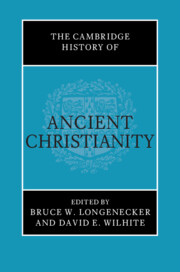Book contents
- The Cambridge History of Ancient Christianity
- The Cambridge History of Ancient Christianity
- Copyright page
- Contents
- Figures
- List of Contributors
- Editors’ Preface
- Part I Contested Contexts
- Part II Contested Figures
- Part III Contested Heritage
- 9 Jews and Christians in Pagan Antiquity
- 10 The Marcionite Option
- 11 The Gnostic Options
- 12 Early Christian Involvement in Classical Education, Literature, and Philosophy
- 13 Scriptures and Interpretations in Early Christian History
- Part IV Contested Cultures
- Part V Contested Beliefs
- Part VI Contested Bodies
- Ancient Sources
- Modern Authors
- References
13 - Scriptures and Interpretations in Early Christian History
from Part III - Contested Heritage
Published online by Cambridge University Press: 23 August 2023
- The Cambridge History of Ancient Christianity
- The Cambridge History of Ancient Christianity
- Copyright page
- Contents
- Figures
- List of Contributors
- Editors’ Preface
- Part I Contested Contexts
- Part II Contested Figures
- Part III Contested Heritage
- 9 Jews and Christians in Pagan Antiquity
- 10 The Marcionite Option
- 11 The Gnostic Options
- 12 Early Christian Involvement in Classical Education, Literature, and Philosophy
- 13 Scriptures and Interpretations in Early Christian History
- Part IV Contested Cultures
- Part V Contested Beliefs
- Part VI Contested Bodies
- Ancient Sources
- Modern Authors
- References
Summary
Early Christians and their Scriptures existed within a complex ecosystem. Christians across all sectors of late ancient Roman society encountered their collections of sacred writings in diverse and sometimes contradictory ways. We detect a spectrum of dispositions, activities, and projects in their engagements with these texts. Their message was continuously adapted to new and disparate forms of life. And discourses quickly emerged around these Scriptures that were sometimes heated – as a central religious artifact, they not surprisingly became the subject of important controversies. Early Christian leaders pronounced increasingly sophisticated accounts of their subject matter, functions, and readers, but often hidden from our sight were the different venues, such as homes, schools, churches, and libraries, that diversely configured an array of textual activities. And, of course, Bibles were themselves pluriform. They circulated in different materials and formats, and their contents – from readings of individual words to the number and order of books they transmitted – were often highly discrepant.
- Type
- Chapter
- Information
- The Cambridge History of Ancient Christianity , pp. 298 - 322Publisher: Cambridge University PressPrint publication year: 2023

